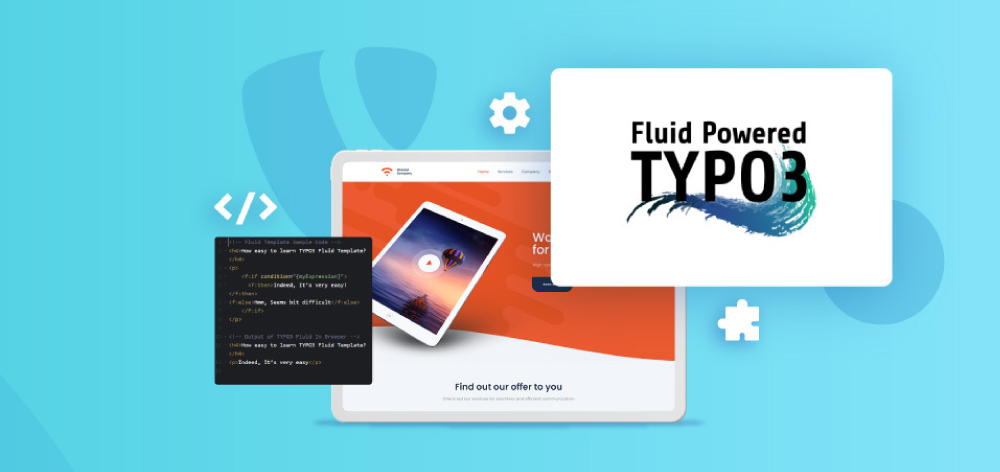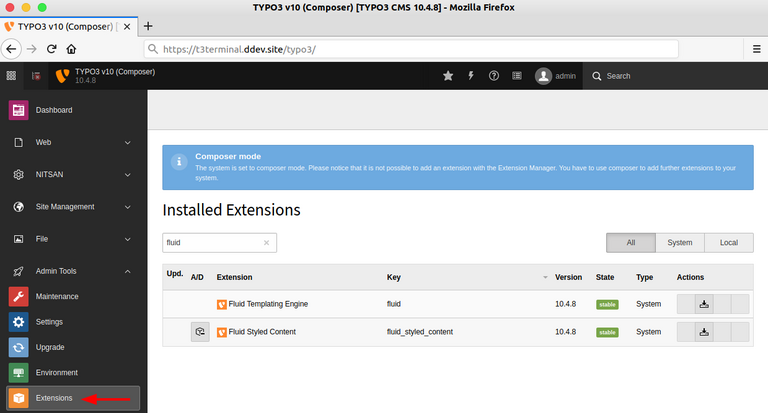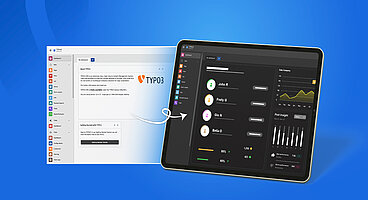TYPO3 Fluid - A fast & secure template engine of TYPO3 CMS. No matter, if you are a TYPO3 developer or TYPO3 integrator; You must have expertise in TYPO3 fluid. Are you looking for essential advanced level TYPO3 Fluid skills? You landed at the right place; here we go!
TYPO3 Fluid is helpful for creating TYPO3 templates or for custom extension development. It’s the heart of TYPO3 to render UI/UX. This article will learn what/why fluid, history of fluid, basic architecture, useful viewhelpers, custom viewhelper, best practices, tips & tricks of TYPO3 Fluid.
Namaste, my dear TYPO3 reader, As you know, my ritual ;) Before we start - Let’s remember the TYPO3 people who contributed to the TYPO3 Fluid Open Source project. I appreciate their time and efforts - Let’s give big hands #T3Kudos!
What's TYPO3 Fluid?
“TYPO3 Fluid - A fast, secure and extendible template engine for PHP.”
- typo3.org
It means TYPO3 fluid is mainly used by the Frontend developers who integrate HTML/CSS/JavaScript to output at the website. While incorporating your templates in TYPO3, you don’t require knowledge of PHP scripting language - Just use innovative TYPO3 Fluid ;)
Why TYPO3 Fluid?
Why does the TYPO3 community create a fluid template engine?
- Security: TYPO3 always focuses on security; Fluids protect against usual security threats like XSS.
- Extendibility: TYPO3 Fluid is very flexible to use and extend unlimited ways.
- Easy to Use: Whole TYPO3 Fluid has been designed with simple XML, so it’s very comfortable to use in HTML templates; you don’t require any special syntax ;)
Your First Impression to TYPO3 Fluid Code
Take a quick look at the sample code of TYPO3 fluid code, and I’m sure it’s pretty easy to read and understand.
<!-- Fluid Template Sample Code -->
<h4>How easy to learn TYPO3 Fluid Template?</h4>
<p>
<f:if condition="{myExpression}">
<f:then>Indeed, It’s very easy!</f:then>
<f:else>Hmm, Seems bit difficult</f:else>
</f:if>
</p>
<!-- Output of TYPO3 Fluid In Browser -->
<h4>How easy to learn TYPO3 Fluid Template?</h4>
<p>Indeed, It’s very easy</p>
History of TYPO3 Fluid
TYPO3 Fluid’s history is slightly different; it was initiated in 2008 for TYPO3 Extbase and TYPO3 Phoenix (aka Neos CMS). And, the TYPO3 community decided to use the TYPO3 Fluid template engine in the TYPO3 core too.
Mr. TYPO3 Fluid Man - Claus Due refactored the codebase in a standalone package; It was then used as a library since TYPO3 v8 and Neos/Flow Framework.
Installation of TYPO3 Fluid
EXT.fluid is part of the TYPO3 core system extension; you don’t need to perform any extra steps to install and configure.
Sometimes your TYPO3 administrator may miss to consider EXT.fluid_styled_content extension in composer-based TYPO3 installation. You can install it as below.
composer require typo3/cms-fluid-styled-content
Support & Help on TYPO3 Fluid
Are you facing any problems with TYPO3 fluid? You can find further development found at https://github.com/TYPO3/Fluid. You can also submit tickets or questions at Github.
Who Needs TYPO3 Fluid?
TYPO3 itself requires the Fluid template engine because the whole TYPO3 backend has been rendered with TYPO3 Fluid. As this engine does not know anything about TYPO3, the engine is extended by TYPO3 within the system extension ext:fluid.
Apart from that, Frontend developers who are developing frontend templates with HTML, CSS, JS will need to learn TYPO3 fluid. You can easily integrate your TYPO3 template using TYPO3 Fluid.
Basics of TYPO3 Fluid
Let’s begin learning TYPO3 fluid from basics like the structure of files, syntax, etc.
File Structure of TYPO3 Fluid
Take a look at the below folders and file structure, “Layouts, Partials, Templates” main design of TYPO3 Fluid. We will learn in-depth in the following sections.
typo3conf/ext/xtension_key
└── Resources
├── Private
│ ├── Languages
│ ├── Layouts
│ │ └── Layout1.html
│ ├── Partials
│ │ └── MyPartial.html
│ └── Templates
│ └── Template1.html
└── Public
├── CSS
├── Images
└── JavaScript
Syntax of TYPO3 Fluid
TYPO3 Fluid has two main syntax formats 1. Tags mode, 2. Inline Notation. Mostly you will need to use tags-mode, e.g., <f:format.html />, But you will need to display something in the tag’s attribute, then you can use Inline notation, e.g., class=”my-class-{variable}”.
Tag vs Inline Mode
<!-- Example of Tag TYPO3 Fluid Code -->
<f:count>{arrVariable}</f:count>
<!-- Example of In-line Notation TYPO3 Fluid Code -->
{arrVariable -> f:count()}
<!-- Bad Example - When In-line Notation -->
<ol class="item-count-<f:count>{arrVariable}</f:count>">
My List
</ol>
<!-- Good Example - When In-line Notation -->
<ol class="item-count-{arrVariable -> f:count()}">
My List
</ol>
TYPO3 Fluid Expression
In Inline-notation, Expression “{}” is one of the hearts of TYPO3 fluid, where you can render anything as well as set conditions.
{variable}
{myArray -> f:count()}
{myPossiblyArray as array}
{checkVariable ? thenVariable : elseVariable}
{myNumber + 3}
The Architecture of TYPO3 Fluid
TYPO3 fluid has central three pillars,
- Templates are the individual files you either render directly or resolve using a controller name and action.
- Layouts that are optional, shared files that are used by Templates and which render sections from Templates.
- Partials are the shared files that can be rendered from anywhere inside Fluid and contain reusable design bits.
1. Prepare Templates
<!-- File: /typo3conf/ext/extension_key/Resources/Private/Templates/MyTemplate.html -->
<html xmlns:f="http://typo3.org/ns/TYPO3/CMS/Fluid/ViewHelpers"
data-namespace-typo3-fluid="true">
<!-- Define section block call “MyTemplate” -->
<f:section name="MyTemplate">
The main template’s section will render.
</f:section>
<!-- Let’s Call “Main” section for testing -->
<f:render section="MyTemplate" />
</html>
2. Prepare Layouts & Call Templates
<!-- File: /typo3conf/ext/extension_key/Resources/Private/Layouts/MyLayout.html -->
<html xmlns:f="http://typo3.org/ns/TYPO3/CMS/Fluid/ViewHelpers" data-namespace-typo3-fluid="true">
<!-- Define Layout -->
<f:layout name="MyLayout" />
<!-- Let’s Call “Main” from Templates -->
<f:render section="MyTemplate" />
</html>
3. Prepare Partials & Call at Templates
Partials are the smallest part of the TYPO3 fluid; you can call partials anywhere into Templates, Layouts, and or-even into other Partials.
Prepare Partial
<!-- File: /typo3conf/ext/extension_key/Resources/Private/Partials/MyPartial.html -->
<html xmlns:f="http://typo3.org/ns/TYPO3/CMS/Fluid/ViewHelpers" data-namespace-typo3-fluid="true">
<p>My First Partial: {variable}</p>
</html>
Let’s Call-In Template
<!-- File: /typo3conf/ext/extension_key/Resources/Private/Templates/MyTemplate.html -->
<html xmlns:f="http://typo3.org/ns/TYPO3/CMS/Fluid/ViewHelpers" data-namespace-typo3-fluid="true">
<!-- Define section block call “MyTemplate” -->
<f:section name="MyTemplate">
<!-- Call Partials here… ->
<f:render partial="MyPartial" arguments="{variable: ‘my-value’}" />
</f:section>
<!-- Let’s Call “Main” section for testing -->
<f:render section="MyTemplate" />
</html>
TYPO3 Fluid ViewHelpers
ViewHelpers are built-in special partials available within TYPO3 Fluid. Fortunately, the TYPO3 community already created many ViewHelpers, which can save our time by avoiding writing custom Partials ;)
Useful Fluid ViewHelpers
Here, I want to let you know the most valuable and crucial TYPO3 Fluid ViewHelpers, which can be used in your daily life TYPO3 fluid templates.
<!-- f:format.* -->
<f:format.date>{dateObject}</f:format.date>
<!-- Output: 1980-12-13 -->
<!-- f:format.case -->
<f:format.case>Some Text with miXed case</f:format.case>
<!-- Output: SOME TEXT WITH MIXED CASE -->
<!-- f:format.nl2br -->
<f:format.nl2br>{text_with_linebreaks}</f:format.nl2br>
<!-- Output: Text with line breaks replaced by <br /> -->
<!-- f:format.stripTags -->
<f:format.stripTags>Some Text with <b>Tags</b></f:format.stripTags>
<!-- Output: Some Text with Tags -->
<!-- f:link.* -->
<f:link.typolink parameter="{link}">
Linktext
</f:link.typolink>
<!-- Output: <a href="/page/path/name.html?X=y" title="testtitle with whitespace" target="_blank">
Linktext
</a> -->
<!-- f:widget.* -->
<f:widget.paginate objects="{blogs}" as="paginatedBlogs">
use {paginatedBlogs} as you used {blogs} before, most certainly inside
a <f:for> loop.
</f:widget.paginate>
<!-- f:debug -->
<f:debug>{testVariables.array}</f:debug>
<!-- Output: Debug screen -->
<!-- f:cObject -->
<f:cObject typoscriptObjectPath="lib.customHeader" data="{article}" currentValueKey="title" />
<!-- Output: Display from your defined TypoScript object
lib.customHeader = COA
lib.customHeader {
10 = TEXT
10.field = author
20 = TEXT
20.current = 1
}
-->
<!-- f:image -->
<f:image src="EXT:myext/Resources/Public/typo3_logo.png" alt="alt text" />
<!-- Output: <img alt="alt text" src="/en/blog/typo3conf/ext/myext/Resources/Public/typo3_logo.png" width="396" height="375" /> -->
<f:image image="{imageObject}" />
<!-- Output: <img alt="alt set in image record" src="fileadmin/_processed_/323223424.png" width="396" height="375" /> -->
Inline Notation
{f:image(src: 'EXT:viewhelpertest/Resources/Public/typo3_logo.png', alt: 'alt text', minWidth: 30, maxWidth: 40)}
<!-- f:media -->
<f:media file="{file}" width="400" height="375" />
<!-- Output: <img alt="alt set in image record" src="fileadmin/_processed_/323223424.png" width="396" height="375" /> -->
<f:media file="{file}" width="400" height="375" />
<!-- Output: <video width="400" height="375" controls><source src="fileadmin/user_upload/my-video.mp4" type="video/mp4"></video> -->
<!-- f:translate -->
<f:translate key="key1" />
<f:translate key="LLL:EXT:myext/Resources/Private/Language/locallang.xlf:key1" />
{f:translate(key: 'someKey', arguments: {0: 'dog', 1: 'fox'}, default: 'default value')}
<!-- Your XLFF File -->
<trans-unit id="someKey" resname="someKey">
<source>Some text about a %s and a %s.</source>
</trans-unit>
<!-- f:form.* -->
<f:form action="..." name="customer" object="{customer}">
<f:form.hidden property="id" />
<f:form.textfield name="myTextBox" value="default value" />
<input type="text" name="myTextBox" value="default value" />
</f:form>
<!-- f:comment -->
<f:comment>Some coment</f:comment>
Variables, Conditions, Loops in TYPO3 Fluid
TYPO3 Fluid smartly provides features to define variables, conditions, and loops to display data in a customizable way.
TYPO3 Fluid Variables
{f:variable(name: ‘FluidVariable’, value: ‘Assign Value’)}
<f:variable name=”FluidVariable”>Assign Value</f:variable>
TYPO3 Fluid If Condition
<f:if condition="{FluidVariable} > 100">
<f:then>True</f:then>
<f:else>False</f:else>
</f:if>
TYPO3 Fluid Foreach Loop
<f:variable name=”FluidArray”>{fruit1: ‘apple’, fruit2: ‘pear’, fruit3: ‘banana’, fruit4: ‘cherry’}</f:variable>
<f:for each=”{FluidArray}” as=”fruit” key=”label”>
<li>{label}: {fruit}</li>
</f:for>
TYPO3 Fluid Switch Case Condition
<f:switch expression=”{person.gender}”>
<f:case value=”male”>Mr.</f:case>
<f:case value=”female”>Mrs.</f:case>
<f:defaultCase>Mr. / Mrs.</f:defaultCase>
</f:switch>
How To Create Custom TYPO3 Fluid ViewHelper?
As mentioned at the beginning, TYPO3 fluid provided unlimited extendibility. Suppose you want to create your own ViewHelper which can manipulate and display end-result. TYPO3 fluid allows to create custom TYPO3 viewhelper by writing a few PHP scripts and renders. Here is the simple example of TYPO3 fluid viewhelper.
Step 1. Create Custom View Helper’s PHP Class
<?php
// File: /typo3conf/ext/extension_key/Classes/ViewHelpers/MystyleViewHelper.php
namespace Vendor\Package\ViewHelpers;
class MystyleViewHelper extends \TYPO3Fluid\Fluid\Core\ViewHelper\AbstractViewHelper
{
/**
* initialize
*
*/
public function initializeArguments()
{
$this->registerArgument('text', 'string', 'My custom argument', true);
}
/**
* render inline text
* @param array $attributes attributes to add
* @return string content
*/
public function render()
{
$content = '<div class="my-custom-style">'.$this->arguments['text'].'</div>';
return $content;
}
}
?>
Step 2. Use Your ViewHelper at Templates/Partials/Layouts
<!-- File: /typo3conf/ext/extension_key/Resources/Private/Templates/YourTemplate.html-->
{namespace ns=Vendor\Package\ViewHelpers}
<!-- Tag Based ViewHelper -->
<ns.mystyle text="Special content" />
<!-- Inline Notation ViewHelper -->
{ns:mystyle(text:'Special content')}
Tips & Tricks of TYPO3 Fluid
That’s it to learn the basics to advanced level knowledge of TYPO3 Fluid. But still, I want to share a few excellent tips and tricks to explore more about TYPO3 fluid.
Reference of EXT.fluid_styled_content
While you are learning the structure and syntax of TYPO3 fluid, it’s always good to explore TYPO3 core’s system extension EXT.fluid_styled_content.
Fluid Powered TYPO3
Fluid Powered TYPO3 is a family of TYPO3 extensions designed to boost productivity and flexibility when creating CMS templates.
- FluidTYPO3.org
Meet Fluid + Atom Design
Fluid Components for TYPO3 enables frontend developers to implement consistent web designs with reusable components. Fluid Style Guide provides a dedicated frontend workshop as well as a powerful collaboration tool for all project stakeholders.
IDEs Support TYPO3 Fluid
TYPO3 Fluid FOSS Support
This plugin is in an early draft stage. The project aims to provide a fully OpenSource plugin for the Fluid Template Language.
VS Code TYPO3 Fluid Snippets
A collection of snippets for the TYPO3 Fluid syntax.
TYPO3 Code Snippets
TYPO3 Code Snippet integration. Just type the letters 't3' to get a list of all available TYPO3 Code Snippets.
TYPO3 VHS Snippets
A collection of snippets for the TYPO3 VHS: Fluid ViewHelpers
flux-snippets
Snippets for TYPO3 Flux ViewHelpers
TYPO3 Books
You can learn TYPO3 Fluid from available TYPO3 Extbase and Fluid Books. Explore Best TYPO3 Books.
24 Fluid Tips
In December of 2017, Claus Due (Developer and Maintainer of TYPO3 Fluid) shared 24 valuable Tips and Tricks. This Post republishes all of them for future reference. Take a look at 24 Fluid Tips.
Fluid Tags Convert to Inline Notation
To save your time, there is an online tool to convert your Fluid tags to inline notation. Explore http://www.fluid-converter.com/
Common TYPO3 Fluid Templates Method
Last but not least, although we have a powerful TYPO3 Fluid template engine, TYPO3 does not have a common TYPO3 template method. Of course, we have too much flexibility, and everyone has their own approach to create a TYPO3 template ;) I recommend reading the below article.
Closure!
Thanks for reading my article; I hope you like and explore fundamental to advanced level TYPO3 fluid skill.
No matter, If you want to become a TYPO3 integrator or developer, you should have expertise in the TYPO3 fluid template engine. Do you have any questions, or facing any TYPO3 Fluid issues? Or, Do you know any better resources to learn TYPO3 Fluid? Feel free to write to the comment box, and I’ll be happy to help you.
And if you’re excited about how AI is changing the TYPO3 world, don’t miss what’s happening in the TYPO3 AI Universe — where TYPO3 and AI come together to simplify workflows and inspire innovation.
Have a Happy Templating With Awesome TYPO3 Fluid!
Post a Comment
-
I've always been intrigued by TYPO3 Fluid, but never knew where to start. Your blog post served as the perfect introduction, taking me from the basics to more advanced techniques. I appreciate how you made the learning process enjoyable and accessible. Great job!







Wolfgang Weber
Brand & Communication LeadWolfgang Weber gestaltet TYPO3 mit Leidenschaft und Expertise. Als langjähriger TYPO3-Enthusiast hat er zu zahlreichen Projekten beigetragen, die Websites schneller und sicherer machen. Abseits von TYPO3 findet man ihn…
More From Author